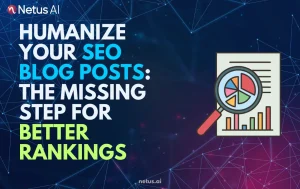
Why Google’s ‘Who, How, Why’ Framework Matters for EEAT | NetusAI
Why Google’s ‘Who, How, Why’ Framework Matters for EEAT AI can create articles in seconds. But here’s the truth: speed is not enough. Google wants

Content writer and editor for Netus.AI
Comparing Texts Help Find Plagiarism in Hebrew. Plagiarism is a major concern in the academic world, posing a threat to both students’ careers and the integrity of educational institutions. Intentional or not, plagiarism can lead to severe consequences for students, especially in subjects like Hebrew courses, which are prevalent in religious studies programs globally. Research papers and other written assignments in these courses often put students at risk of accidentally plagiarizing materials due to the unique nature of Hebrew texts.
Educators and academic institutions take plagiarism very seriously, creating strict rules and guidelines to prevent it from happening. Students who are found guilty of plagiarizing can face expulsion or receive failing grades, negatively impacting their academic and professional future. As a result, it’s crucial for students to use plagiarism detection tools to ensure the originality of their work in any language, including Hebrew.
When comparing text, it’s essential to use an online text comparison tool that can accurately analyze similarities and differences between documents. These tools are capable of comparing content against other works found online, ensuring a thorough and efficient evaluation. To compare two text files or PDF files, use an article checker tool that allows side-by-side comparison. Utilizing these tools simplifies the process and minimizes the risk of inaccuracies, making it an ideal method for students to check their work for plagiarism before submission or publication.
Hebrew’s prevalence in major universities, colleges, and online blogs has led to an increase in the likelihood of encountering plagiarized content. Students studying Hebrew often need to produce academic articles, which may contain borrowed ideas or information from existing sources, such as blogs, journals, or other publications. This problem extends to researchers in the field as well.
One common form of plagiarism occurs when students or writers use someone else’s words without including quotes or proper citations. In some cases, plagiarism can result from a lack of knowledge about proper citation practices, leading students to believe that online sources do not require attribution[^1^].
Accidental plagiarism is another issue that arises when students incorporate similar phrases from source material that remain in their memory while working on their assignments. An oversight in citation, incorrect quotations, or misspellings can also result in unintended copied content[^2^].
To avoid plagiarism in Hebrew writing, it is essential for students, researchers, and writers to use online checker tools designed to detect such instances. These tools can help identify and prevent potential plagiarism, ensuring academic integrity.
Plagiarism in online blogs and articles can also be detrimental to a blogger’s career. Using published content without proper acknowledgment or quotation may lead to flagging for plagiarism, which can damage the blogger’s reputation and result in decreased readership. Search engines might also penalize the blog, reducing its visibility and reach[^3^]. Therefore, bloggers should be diligent in checking for plagiarism in Hebrew content to maintain their credibility and online presence.
In conclusion, plagiarism can occur in languages like Hebrew for various reasons, including lack of knowledge, accidental copying, and improper citations. To prevent this issue, it is vital for students, researchers, writers, and bloggers to employ plagiarism-detection tools and follow proper citation practices, ensuring the integrity and originality of their work.
Whether writing academic papers or conducting research, proper citation is essential for avoiding plagiarism. Be sure to maintain a comprehensive list of reference materials used in research papers to substantiate the findings.
Citations are necessary whenever parts of previously published work are incorporated, even if that work belongs to the author. This includes verbatim quotes and instances of self-plagiarism. When citing, include important details such as the work’s title, author, publication date, page number, edition, and any translators if applicable.
In addition to directly quoted material, paraphrased content also requires relevant citations. Paraphrased information does not need quotation marks but must be attributed correctly.
Various sources can be used for reference materials, such as:
Tables and bullet points can be employed to format and convey information concisely. It is critical to avoid making exaggerated or false claims in any academic endeavor.
If uncertain about proper citation, students can utilize plagiarism checker tools to identify any plagiarized content and its sources. Ultimately, when in doubt, always remember to cite the reference material to maintain academic integrity and avoid any potential plagiarism issues.
Using text comparison tools like Copyleaks, it becomes easy to identify plagiarism in text documents. Here’s a brief overview of the process:
Remember, the key to avoiding plagiarism is utilizing comparison tools, citing sources correctly, and maintaining originality in your content.
To check Hebrew text for plagiarism effectively, you can use specialized plagiarism detection software or services that support the Hebrew language. These tools usually have algorithms that can recognize sentence structures, synonyms, and paraphrases, making it easier to identify potential plagiarism cases within Hebrew texts.
Several tools are available for detecting plagiarism in Hebrew language documents. Some examples include Copyleaks and Scribbr. These platforms provide support for multiple languages, including Hebrew, and help in identifying potential plagiarism cases.
Yes, many online plagiarism checkers are designed to handle translation variations when comparing texts. These tools employ sophisticated algorithms that can analyze on sentence patterns, structures, and vocabulary in multiple languages, making it possible to detect potential plagiarism cases in translated documents.
Effective methods for identifying cross-language plagiarism include utilizing specialized tools that support multiple languages and employing natural language processing (NLP) techniques. These approaches allow the tools to analyze the content from various angles, such as lexical and structural similarities, which helps in detecting plagiarism across different languages.
When using plagiarism detection software for Hebrew texts, consider the software’s language support, effectiveness in handling translation variations, and its ability to capture both direct and paraphrased plagiarism. Additionally, ensure the tool provides accurate and reliable results by checking its reputation and customer reviews.
While tools like Grammarly and Turnitin are widely used for plagiarism detection, their accuracy in detecting plagiarism in translated texts may vary. It is essential to choose a software that specifically supports Hebrew language and has robust cross-language plagiarism detection capabilities, such as Copyleaks or Scribbr, to ensure accurate results.

Why Google’s ‘Who, How, Why’ Framework Matters for EEAT AI can create articles in seconds. But here’s the truth: speed is not enough. Google wants

SEO Writer’s Guide to Google’s Helpful Content Update Keeping up with Google’s algorithm changes can feel like a relentless game of whack-a-mole. Just when you

Can AI Content Be Safe for SEO in 2025? Let’s start with the question of keeping every content strategist, SEO pro and blogger awake at

Humanize Your SEO Blog Posts: The Missing Step for Better Rankings You’ve done everything by the book. Your keyword research is impeccable. Your meta descriptions

How to Pass AI Detection Tests as an SEO Writer Let’s paint a familiar picture. You’ve just finished a blog post. The headline is sharp,

Why Your AI SEO Blog Isn’t Ranking (And How to Fix It) You embraced AI for your blog. The promise was intoxicating: high-quality content, published
@ 2024 Netus AI.